To establish a clutter-free homework zone, choose a quiet, well-lit space away from distractions, and set up ergonomic furniture for comfort. Use vertical storage like wall shelves to maximize space and keep supplies organized in baskets and drawers. Keep surfaces clear by implementing routines for tidying up after each session, and set clear boundaries around study time and workspace. Continue exploring ways to maintain your tidy zone and create an inviting, focus-friendly environment.
Key Takeaways
- Designate a specific, clutter-free area solely for homework to reinforce boundaries and focus.
- Use vertical storage like wall-mounted shelves and baskets to maximize space and reduce surface clutter.
- Implement regular tidying routines, including weekly decluttering, to maintain an organized workspace.
- Incorporate designated storage solutions for supplies, ensuring everything has a specific place after each use.
- Minimize distractions by removing unnecessary items and keeping only essential materials within reach.
Choosing the Ideal Location for a Homework Area
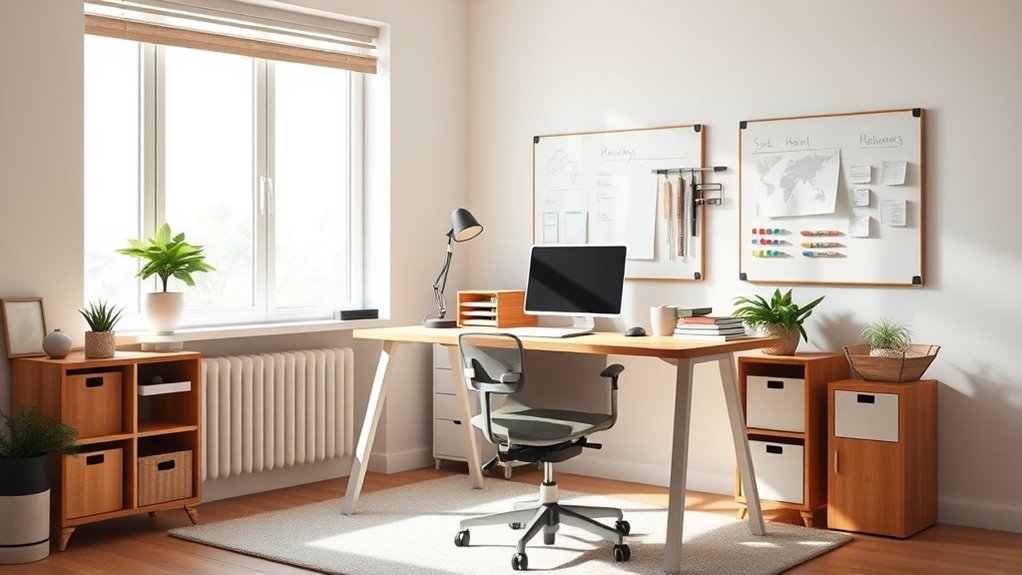
Choosing the right location for a homework area is crucial because it sets the tone for focus and productivity. You want a space with good study desk ergonomics to prevent strain and discomfort during long sessions. Look for a quiet, well-lit spot away from distractions like TV or busy household areas. Consider the power outlets for laptops or devices, and verify there’s enough room for your supplies. Pay attention to color psychology; calming colors like blue or green can enhance concentration, while too much stimulation from bright hues might hinder focus. A strategic location helps your child develop a routine and minimizes interruptions. Incorporating vertical storage solutions can also maximize space and keep supplies organized, further promoting a productive environment. By selecting a dedicated, comfortable, and well-designed space, you’re setting the foundation for successful homework sessions.
Selecting Functional and Compact Storage Solutions
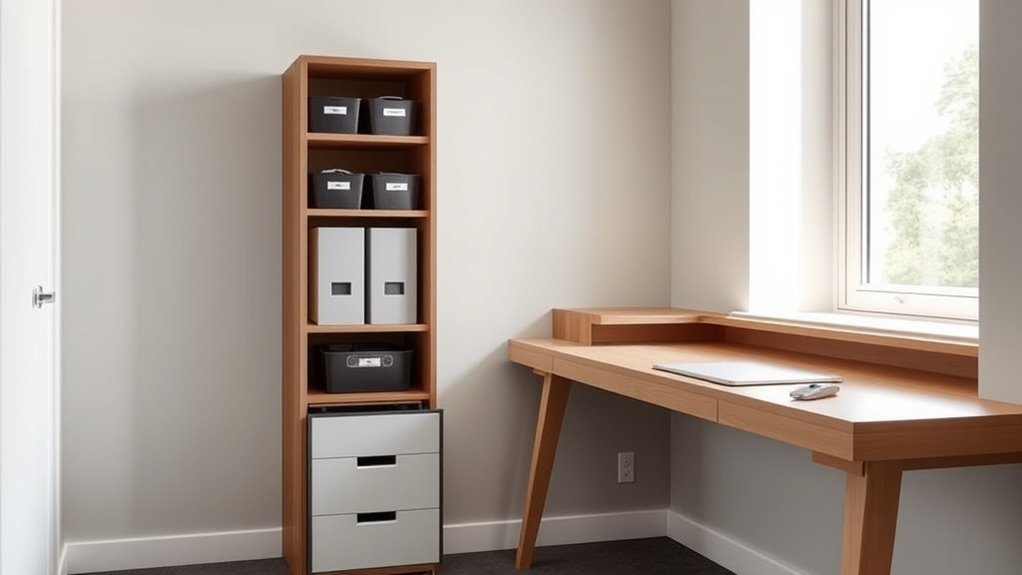
To keep your child’s homework area organized and clutter-free, selecting functional and compact storage solutions is essential. Use storage baskets to quickly gather supplies and keep surfaces clear. Wall-mounted shelves maximize vertical space, providing easy access to books, stationery, and notebooks without taking up desk area. Choose baskets that fit neatly on shelves or inside cabinets, ensuring everything has a designated spot. This setup encourages independence and makes cleanup effortless. Here’s a simple example:
| Storage Solution | Benefits | Ideal Use |
|---|---|---|
| Storage baskets | Keep supplies organized, portable | Storing pens, papers, small items |
| Wall-mounted shelves | Save space, display items attractively | Books, educational materials |
| Compact drawers | Hidden storage, easy to access | Art supplies, chargers |
This combination keeps the zone tidy and functional, without sacrificing style. Additionally, incorporating storage organization techniques can further enhance the efficiency of the space.
Designing an Inviting and Focus-Friendly Environment
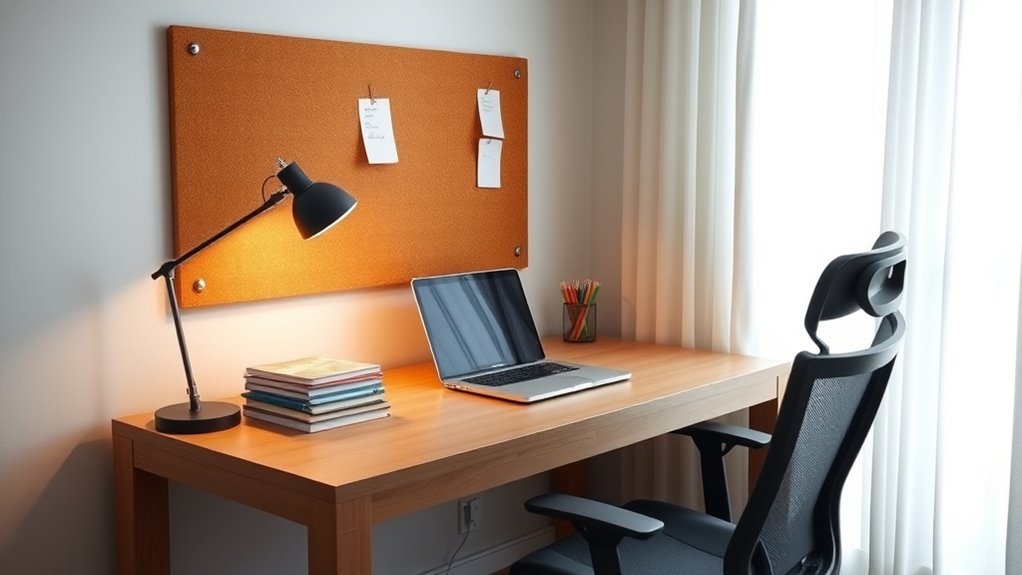
Creating an inviting and focus-friendly environment starts with thoughtful design that encourages concentration and comfort. You want a space that motivates and minimizes distractions. Incorporate motivational decor, such as inspiring quotes or colorful accents, to boost enthusiasm. Use ergonomic furniture that supports good posture and reduces fatigue, helping your child stay focused longer. To optimize the space, consider these key elements:
- Select a comfortable, adjustable chair and desk for proper ergonomics.
- Add motivational decor to create a positive atmosphere.
- Keep the area well-lit with natural or bright, glare-free lighting.
- Minimize clutter with strategic storage to promote focus.
- Incorporate elements inspired by Waterparks, such as themed decor or vibrant colors, to make the homework zone more engaging and inviting.
Establishing Clear Boundaries and Routines
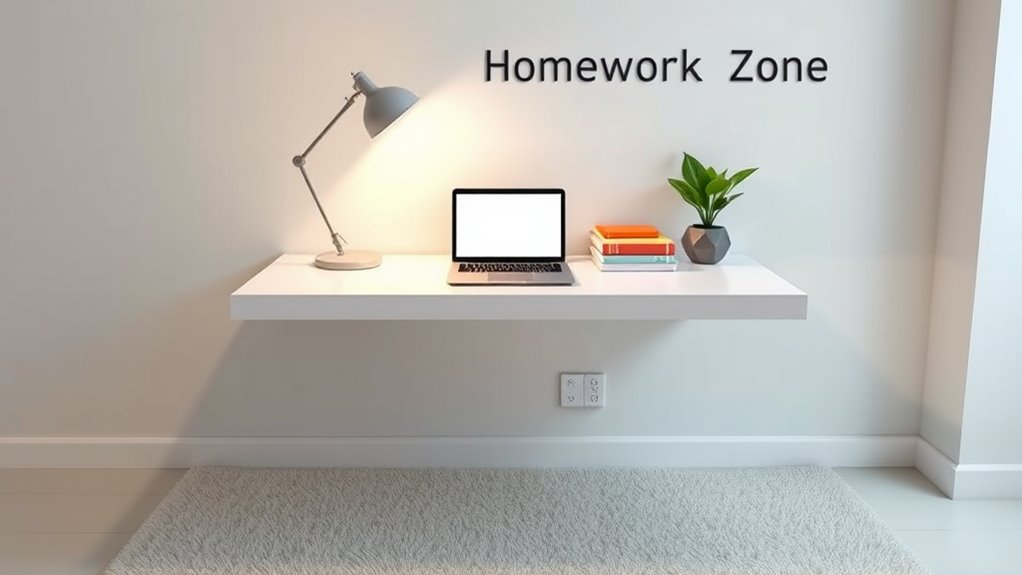
Establishing clear boundaries and routines is essential for helping your child stay focused and develop good study habits. By setting specific times for homework and defining a dedicated workspace, you create a structured environment that minimizes distractions. Use motivational strategies like positive reinforcement to encourage consistent effort, making routines more engaging. Incorporate time management techniques such as breaking homework into manageable segments and using timers to build a sense of accomplishment. Consistency is key, so stick to the schedule and boundaries you establish. When your child knows what to expect, it reduces confusion and resistance, fostering independence. Clear boundaries and routines not only improve focus but also help your child develop valuable skills for managing tasks efficiently. Additionally, understanding the importance of routine consistency can significantly enhance your child’s ability to adapt and thrive in their study environment.
Maintaining Clutter-Free Practices for Long-Term Success
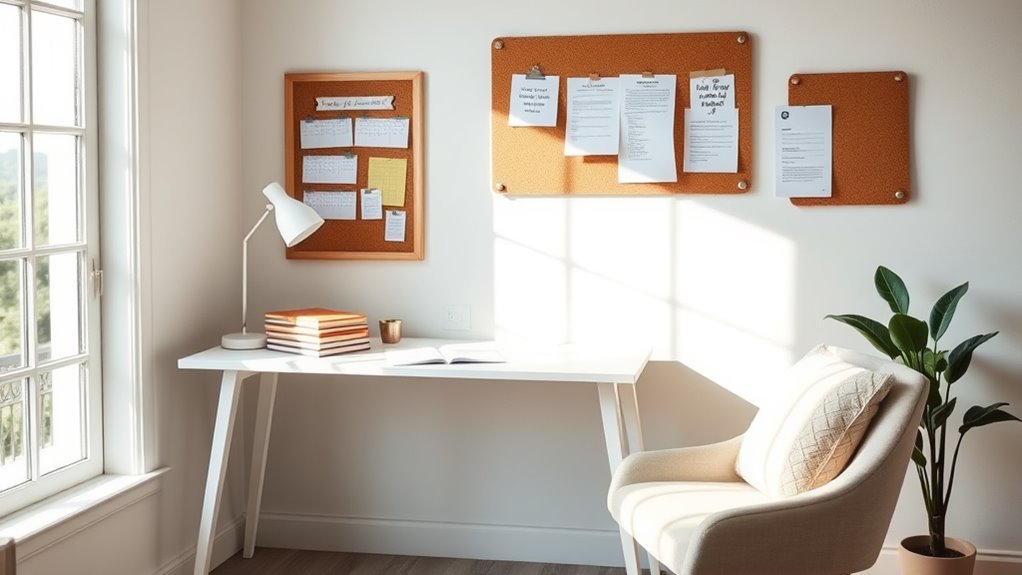
Once you’ve set clear boundaries and routines for homework time, maintaining a clutter-free environment becomes the next step in supporting your child’s long-term success. Your active parental involvement and effective time management are key here. To keep the space organized:
Create a tidy homework space through routine, organization, and your active involvement.
- Regularly review and remove unnecessary supplies.
- Encourage your child to tidy up after each study session.
- Designate specific storage areas for materials.
- Set aside weekly times to declutter together.
- Incorporate organization techniques to sustain a tidy environment effectively.
Frequently Asked Questions
How Can I Motivate My Child to Keep Their Homework Area Tidy?
You can motivate your child to keep their homework area tidy by making it appealing and functional. Use creative storage solutions like colorful bins or shelves to keep supplies organized. Offer motivational rewards, such as praise or small treats, when they maintain tidiness. Encourage their involvement in setting up the space so they feel ownership. These strategies help foster good habits and make cleaning up feel rewarding rather than a chore.
What Are the Best Tools to Minimize Distractions in a Homework Zone?
Think of your child’s homework zone as a lighthouse guiding focus through fog. To minimize distractions, use tools like noise-canceling headphones and a timer to stay on task. Remove digital distractions by turning off notifications and keeping devices out of sight. Invest in ergonomic furniture to keep your child comfortable and alert. These tools help create a calm, focused space where concentration can thrive, like a beacon in a busy world.
How Often Should I Reorganize or Update the Homework Space?
You should revisit and update your homework space every few months to keep it functional. Incorporate new storage solutions as needed for better organization, and establish regular cleaning routines to maintain a clutter-free environment. This way, your space stays efficient and inviting, helping you stay focused. Regular updates guarantee your setup adapts to your changing needs, making homework time more productive and less stressful.
Are There Specific Color Schemes That Promote Focus and Concentration?
Did you know that color psychology shows certain colors can boost focus? For your homework zone, opt for soothing palettes like soft blues or gentle greens—they promote calmness and concentration. Bright reds or yellows might energize, but they can also distract. Choosing calming colors helps create an environment that encourages sustained attention, making your study time more effective and less cluttered, both visually and mentally.
How Can I Involve My Child in Designing Their Homework Area?
You can involve your child in designing their homework area by asking for their input on layout and decor. Encourage creative design by letting them choose colors, posters, or organizational tools that make the space feel inviting. By doing this, you foster ownership and motivation, making them more likely to stay focused. Collaborating on the setup turns it into a fun project and helps guarantee the space suits their preferences.
Conclusion
By setting up a dedicated homework zone, you create a space where focus naturally happens—almost like it’s meant to be. When you choose the right spot, keep it organized, inviting, and routine-driven, everything falls into place. It’s funny how a simple change in your environment can make a big difference. Before you know it, your clutter-free zone becomes the perfect place for your child’s success—almost as if it was waiting for this moment all along.








